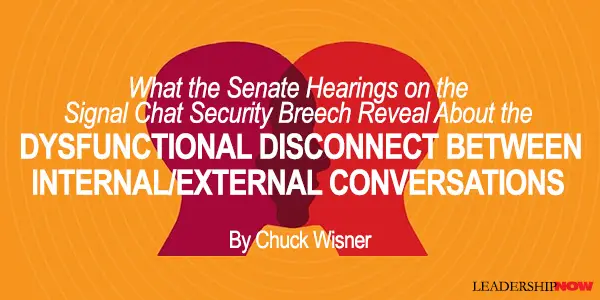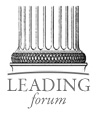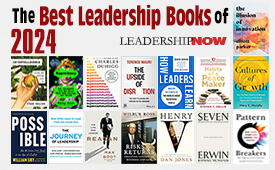 |
 |
04.07.25

What The Senate Hearings on the Signal Chat Security Breach Reveal About the Dysfunctional Disconnect Between Internal/External Conversations
OUR internal conversations may seem inconsequential, but they determine the success of every interaction. They hold secrets to how we can have authentic conversations with others. When CIA Director John Ratcliffe and Director of National Intelligence Tulsi Gabbard recently testified before the Senate regarding the breach of security using Signal’s group chat during an attack on Yemen, their carefully measured responses revealed something profound. As they faced direct questions about the Signal chat, including an accidental text that included Jeffrey Goldberg, editor-in-chief of The Atlantic, viewers witnessed a rare moment when the divide between Ratcliffe and Gabbard’s private thoughts and public speech became apparent. Their shifting gazes and carefully chosen words highlighted a universal human struggle: the gap between what we think and what we say. This chasm creates the tension we carry, the anxiety that keeps us awake, and the misunderstandings that damage our relationships. We all have private conversations with ourselves that no one else hears — the running commentary in our minds, interpreting events, assigning meaning, and shaping our responses to the world. The stories we tell ourselves profoundly shape how we interact with the world, yet we seldom examine these narratives with the scrutiny they deserve. Instead of creating stress by tamping them down, our hidden conversations can be an untapped reservoir of wisdom. Our unprocessed inner dialogues hold insights that could transform superficial exchanges into authentic connections. Our brains as story-making machines Human beings are natural storytellers. Our brains weave narratives to make sense of experiences and create the stories we believe and live by. These internal narratives reflect our beliefs, identities, and perceptions and drive behaviors in ways we often fail to recognize. When we encounter new information, we don’t process it objectively — we filter it through existing stories about ourselves, others, and how the world works. These narratives provide comfort but can trap us in limited perspectives. When your story becomes the only story We are socially conditioned to have “the answer” and rewarded for being the smartest person in the room. Unexplored, our attachment to our narratives can get us into trouble. When we hold tightly to our version of reality — our story about what happened or what something means — we leave little room for mindful listening, alternative perspectives, and collaboration. Like the officials questioned in the Senate hearing, our inability to process and gain wisdom from our private thoughts will trap us in stress. There’s no space for productive dialogue between concerned parties, which guarantees communication breakdowns. When we fail to question our automatic interpretations, we respond to imagined threats rather than actual circumstances. We hear criticism where none exists, assume malicious intent behind neutral actions, and react defensively to perceived slights. Think about your thinking We can develop greater awareness of our internal patterns through metacognition — or thinking about our thinking and creating space between stimulus and response for more intentional communication. Here are practical ways to build this awareness: 1. Expose the stories behind your emotions. When strong emotions arise, identify not just what you’re feeling but the underlying narrative driving that emotion. Our emotions don’t drive our thinking; they’re physical upheavals of our thoughts. Ask yourself: “What story am I telling myself about this situation? What story am I telling myself that’s beneath the negative judgment?” For the officials questioned in the Senate hearing, imagine if they’d felt safe and confident enough to speak their truth and admit their mistakes. This may have led to a commitment to follow the norms that protect confidential information. 2. Mine the facts. Separate observable facts from your interpretations. If someone arrives late to a meeting, the fact is their arrival time. One could assume they are being disrespectful, or one might learn that their child had a bad morning. Grounding yourself in verifiable reality rather than assumptions creates a solid foundation for communication. 3. Process internal opinions through four essential questions When forming judgments, examine them through these lenses: • What are my desires? Identify what you want from the situation. In the Senate hearing, were the officials questioned aiming for obstruction, distraction, or disclosure of truth? • What are my concerns? Acknowledge your fears or worries. Within any opinion lies concerns about outcomes. What worries drove both questioners and the questioned officials in that hearing? Were they able to discuss them? • What power issues are at play? Every conversation involves power issues. Recognizing authority dynamics helps you to navigate conversations. The Senators had the authority to seek facts, but to what authority were the questioned officials committed? • What standards or values are shaping your opinions? Identify the principles or expectations that form the foundation of your judgment. Every judgment we have is fueled by standards that we hold mostly unconsciously. What if all parties in the hearing held the standard that upholding their oath to the Constitution was fundamental? Revealing our inner dialogues — even to ourselves — may initially feel uncomfortable. However, a willingness to examine what usually remains hidden will ultimately lead to more authentic communication. Developing awareness of our inner dialogue exposes patterns we might never notice. This heightened consciousness doesn’t just minimize internal stress — it fundamentally transforms how we connect with others. When we understand the stories driving our reactions, we can choose whether to believe them. As we separate facts from interpretations, we create space for curiosity rather than judgment. And by examining our opinions through multiple lenses, we develop more nuanced perspectives that foster genuine understanding.  
Posted by Michael McKinney at 11:18 AM
|
BUILD YOUR KNOWLEDGE
 

How to Do Your Start-Up Right STRAIGHT TALK FOR START-UPS 
Grow Your Leadership Skills NEW AND UPCOMING LEADERSHIP BOOKS 
Leadership Minute BITE-SIZE CONCEPTS YOU CAN CHEW ON 
Classic Leadership Books BOOKS TO READ BEFORE YOU LEAD |